LIGHT for Class 8 SCIENCE
INTRODUCTION
Hamare chapter ka name hai “Light”. Toh kya aap jante hai light kya hoti hai?
Light energy ki hi ek form hai jiski wajah se hum objects ko dekh paate hai. Agar hamari life mein light hogi hi nahi to hamein kuchh bhi chij dikhai kaise degi? Kyunki light kisi bhi object pe jab padti hai aur uss object se takra kar wapas hamari aankhon par aati hai to hamari aankhen uss light ko observe karti hai. Jiske karan hum chijon ko dekh paate hai. Agar light present naa ho mtlb ki jaise raat ho gai ho aur raat ke samay mein bijli chali gai ho, toh chije sari apni jagah par hoti hai uske bavjud koi bhi chij hamein dikhai nahi deti. Iss chapter mein hum log light ke different phenomenon ke bare mein padhenge, iske laws ke baare mein janege, regular aur diffused reflection ke baare mein janege. Yaha hum multiple images ke formation ke baare mein aur sunlight white ya coloured kaise hoti hai yeh bhi janege. Iss chapter mein hum eye ke structure aur functioning ke baare mein janege aur visually impaired log kaise padh-likh sakte hai, unke liye kya system available hai inn sabhi baato ko janege.
What Makes Things visible?
Hamein hamesha lagta hai ki eyes objects ko dekh pati hai lekin aisa nahi hota. Kya hum andhere mein objects ko dekh paate hai?
Nahi, kyonki objects ko dekhne ke liye akele eyes kafi nahi hai iske liye light ka hona bhi equally important hai. Jab light kisi object par padti hai aur fir object se reflect ho kar hamari eyes mein enter karti hai toh hum objects ko dekh paate hai. Light ke reflect hone ke kuchh laws bhi hai, ab hum inn laws ke baare mein padhenge.
Laws of Reflection
Reflection ke two laws hote hai jo ki light of reflection ke hr cases ke liye follow hote hai.1. First law - Angle of incidence= Angle of Reflection
Light ke reflection mein light ki jo ray source se aa rahi hoti hai usko hum incident ray kehte hai. Yeh incident ray jis surface par padti hai, jaise ki niche diye gaye figure mein dikhaya gaya hai ki incident ray mirror surface pe aa rahi hai. Iss mirror surface ke perpendicular hum ek line khinchte hai, yeh line ussi point pe khinchte hai jis point par plane surface par ray incident hogi. Yeh perpendicular line normal kehlata hai. Ab jo incident ray light ke source se aayi hai woh iss normal line se ek angle banate hue aati hai jise ∠i se show karate hai or jab mirror surface se takrati hai to takrane ke bad jab yeh reflect hoti hai toh iss ray ko hum reflected ray kehte hai jo ki normal se hi ek angle banate hue wapas lout jati hai jise ∠r se show karate hai. Yaha par light ki jo ray incident ho rahi hai aur reflect ho rahi hai yeh dono rays normal ke sath hi angle banati hai jo ki mirror surface ke sath perpendicular draw kiya gaya hai. Incident ray and reflected ray dono normal ke sath equal angle banate hai. Yahi light of reflection ka first law hai.
Incident ray Normal ke sath jitne angle par aaegi normal ke sath utne angle par hi reflected ray jayegi.
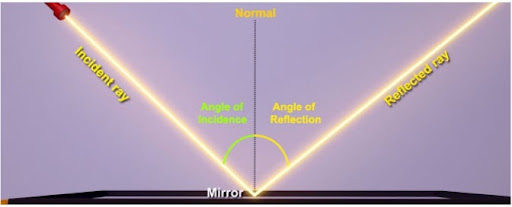
img src="https://d10lpgp6xz60nq.cloudfront.net/physics_images/LN_SELF_PHY_VIII_ENG_PAID_C16_02.png" width="100%">
2. Second law - The incident ray, normal to the mirror at the point of incidence and the reflected ray, all lie in the same plane.
Light reflection mein incident ray, normal aur reflected ray yeh teeno ek hi plane mein hote hai.
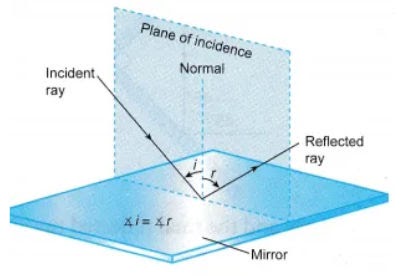
Aane wali ray, jane wali ray aur normal ye teeno same plane mein hi honge.
Lateral inversion - Sideways reversal of the image is known as lateral inversion.
Jab aap kisi object ki image ko mirror pr dekhte hai, tab aapka left side right mein and right side left mein dikhai deta hai. Yahi lateral inversion kehlata hai. Jaise ki niche diye gaye figure mein dikhaya gaya hai.
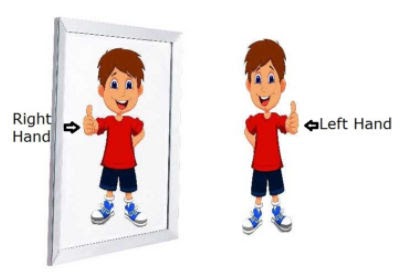
Regular and Diffused Reflection
1. Regular Reflection : Jab incident rays plane ya smooth reflecting surface par parallel aati hai toh same direction mein parallel reflect hoti hai jaisa ki niche diye gaye fig. mein dikhaya gaya hai.

2. Irregular or diffused reflection : Jab incident rays irregular ya khurdure reflecting surface par parallel aati hai to different directions mein reflect hoti hai jaisa ki niche diye gaye fig. me dikhaya gaya hai.
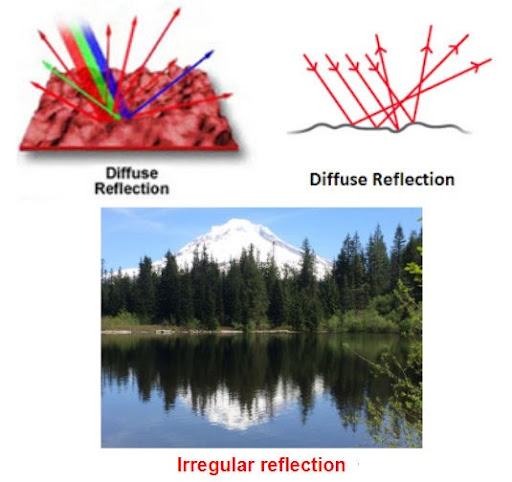
Reflected Light Can Be Reflected Again
Ab tak hamne jana ki light jab ek surface par padti hai toh kaise reflect karti hai lekin kya hamne kabhi yeh socha hai ki yeh light firse reflect ho sakti hai?
Yes aisa possible hai. Hum ek se jyada mirrors ko kuchh certain angles par place karke multiple reflections obtain kar sakte hai, isse multiple times light reflect karegi aur hamein multiple images obtain hongi. Iss phenomenon ko hum certain scenarios mein use kar sakte hai, jaise-
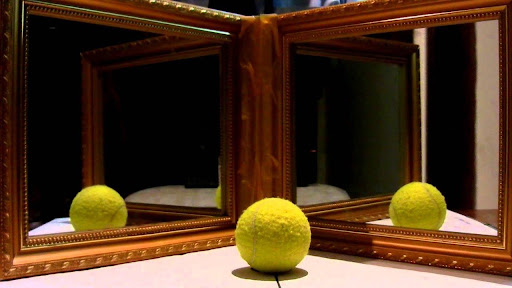
What is a Periscope?
Periscope ek instrument hai jo aise objects ko dekhne ke liye use kiya jata hai jo observer ki line of sight se away hote hai iska matlab hai yeh hidden objects ko dekhne mein help karta hai. Periscope multiple reflections ke phenomenon par work karta hai.
Periscope ke andar do mirrors 45 degree ke angle par inclined hote hai. Inko generally submarines, tanks, bunkers, etc. mein use kiya jata hai.
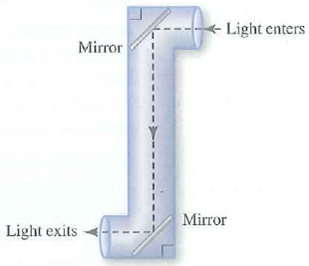 Figure 8 Structure of a Periscope
Figure 8 Structure of a PeriscopeMultiple Images
Hum ek se jyada plane mirrors ka use karke ek object ki multiple images obtain kar sakte hai. Kaleidoscope mein bhi yeh hi idea use kiya jata hai.
Lekin yeh kaleidoscope hota kya hai?
What is a Kaleidoscope?
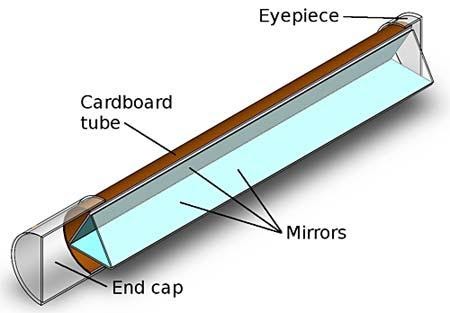
Figure 9 Structure of a Kaleidoscope
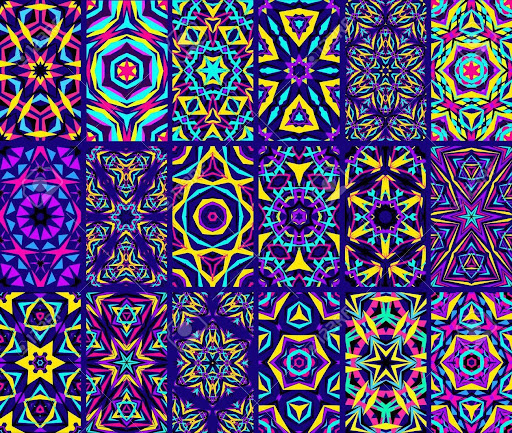 Figure 10 Patterns inside a Kaleidoscope
Figure 10 Patterns inside a KaleidoscopeSunlight- White or Coloured
Sunlight ko white light kaha jata hai lekin yeh seven colours se bani hoti hai.
White light ke seven colours mein split hone ke phenomenon ko dispersion of light kehte hai.

This can be observed when a beam of sunlight is passed through a triangular prism or when light falls on a compact disk (CD). Rain ke bad jab rainbow aata hai toh usme bhi hamein seven colours dikhai dete hai. Iske colours easily distinguishable nahi hote. Isme red, orange, yellow, green, blue, indigo aur violet colour hote hai.
Hum soap bubbles ko bhi dhyan se observe karein toh yeh bhi colourful appear hote hai. Ek compact disk se bhi jab light reflect hoti hai toh different colours najar aate hai.
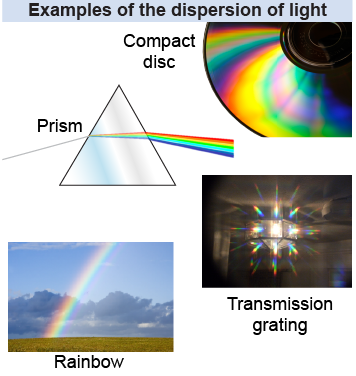
What is inside Our Eyes?
Eyes hamari body ka sabse important sense organs mein se ek hai, isliye ab hum iske structure aur working ke baare mein janege. Hum yaha eyes ke different parts aur unke functions ke baare mein janege.

Eyes ki roughly spherical shape hoti hai. Ab hum iske different parts ke baare mein padhenge.
Eyelids- Sabse pehle eyes ke upar eyelids present hoti hai jo kisi bhi object ko hamari eyes mein jaane se rokti hai.
Sclera - Jab hum kisi ki aankhon mein dekhte hai toh hamein jo dikhta hai woh eyes ka white portion hota hai jise sclera kehte hai. Yeh eyes ke protective layer ka kaam karta hai.
Cornea - Center mein jo circular part hota hai woh transparent layer hota hai jisko hum cornea kehte hai.
Iris - Coloured portion iris kehlata hai jo ki aankhon mein enter karne wali light ko control karta hai.
Pupil - Eyes ka center portion pupil kehlata hai jisse light ankhon mein enter karti hai.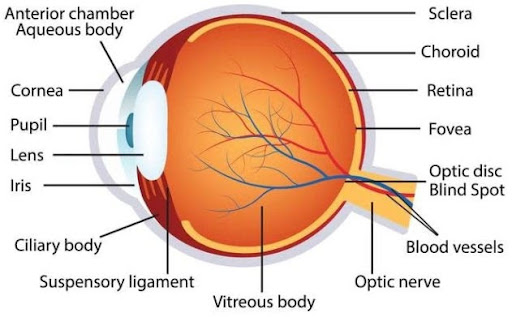
Ab hum eyes ke andar ka side view dekhenge jo upar diye gaye figure mein dikhaya gaya hai. Aap dekh sakte hai ki eyes shape mein spherical jaisa hota hai. Isliye hum isko eye ball kehte hai. Eyes ka approx diameter 25 mm hota hai. Jaisa ki hamne eyes ka front layer dekha jisko cornea kehte hai. Cornea bahar ki taraf nikla hua hota hai aur transparent hota hai. Isliye light aankho mein enter kar pati hai. Cornea ka function light rays ko refract karna hota hai jo ki eyes mein image form karne mein help karta hai.
Aap yaha par dekh sakte hai ki light air se cornea mein enter karti hai. Iris flat, coloured or ring shaped membrane hota hai jo ki cornea ke pichhe hota hai.
Iris ke bich mein pupil hota hai jisse light aankhon mein enter karti hai. Iris ka function eyes mein enter karne wali light ko control karna hota hai. Yeh light ko control karne ke liye pupil ke size ko adjust karta hai. Jab light bright hoti hai toh iris pupil ka size decrease kar deta hai jisse light less amount mein eyes mein enter karti hai taki hum proper dekh sake. Agar dark place ho jaise ki movie theater toh iris pupil ka size increase kar deta hai taki jyada light eyes mein enter kar sake or hum better dekh sake. Aapne notice kiya hoga ki jab aap bright light se dark room me enter karte hai to kuchh time tak apko kuchh thik se dikhai nahi deta kyuki iris pupil ko adjust karne mein thoda time leta hai.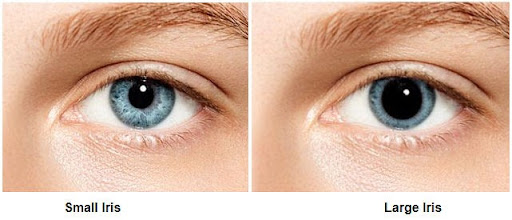
Aqueous humour - Cornea or eye lens ke bich jo liquid hota hai woh aqueous humour kehlata hai. Jiska function eyes ke andar fluid pressure ko maintain karna hota hai. Yeh pressure eye balls ke walls ko tight rakhne mein help karta hai or roughly spherical shape maintain karta hai. Yeh nutrition bhi provide karta hai.
Eye lens - Eye lens transparent soft or flexible hota hai. Kya aap jante hai ki hamare eyes ka lens ek living thing hai jo ki cells se bana hota hai. Human eye mein convex type ka lens hota hai. Jaisa ki aap figure mein dekh sakte hai ki center se lens thick hota hai jbki edges se thin hota hai. Convex lens mein converging action hota hai. Eye lens ka kaam light rays ko refract karna hota hai jiska clear image retina par banta hai. Convex lens flexible hota hai, yeh apni shape or thickness ko change kar sakta hai. Isliye yeh apni focal length ko adjust kar sakta hai jo ki different distance pe rakhe object ko focus kar sakta hai or hamein hamari retina par clear image milta hai. Eye lens ka yeh adjustment power of accommodation kehlata hai jiske bare mein hum aage baat karenge.
Ciliary muscles - Jaisa ki figure mein dikhaya gaya hai ciliary muscles eye lens ki thickness ko change karti hai taki eye lens light rays ko retina par focus kar sake. Yeh eyes ka power of accommodation kehlata hai.
Vitreous humour - Eyes ke pichhe ka space vitreous chamber kehlata hai. Jo ki fluid ko contain karke rakhta hai jise hum vitreous humour kehte hai.
Vitreous humour ka function lens ko support karna or eyes ball ka shape ko maintain karna hota hai. Vitreous humour 99% water hota hai jisse light isse bina deflect hue pass ho pati hai. Yaha par fluid liquid lens ke jaisa act krta hai or aage light rays ko retina par focus karne mein help karta hai.
Retina - Eyes ke back part mein screen hoti hai jaha images form hoti hai. Yeh screen retina kehlata hai.
Retina ek film ke jaisa hota jo ki pehle ke cameras mein hota tha or aaj ke digital cameras mein digital sensor ke jaisa hota hai.
Rods or Cones - Retina large numbers of sensitive cells contain karke rakhta hai jo ki rods or cones kehlata hai.
Rod cell light ki intensity ke liye bahut sensitive hota hai jiske karan hamein roshni or andhere ka difference pata chalta hai. Iske karan object ke colours ko bhi hum pehchan pate hai.
Ager hum kisi room ki light ko kum kar de to kya aap waha present kisi object ka colour bata sakte hai? Nahi kyuki jo cone cell hai usko object ke colour ko pehchanne ke liye proper light ki jarurat hoti hai. Lekin yaha par rod cell work kar raha hai ki iss room mein koi object rakha hua hai. Jab hum lights on kar dete hai, tab hum us room mein rakhe object ke colours ko easily pehchan sakte hai. Iska matlab hai ki rod cell light or dark ka information deta hai or cone cell object ke colours ko pehchan pata hai.
Aap ise easily yaad rakh sakte hai c for cone c for colour.
Optic nerves - Eyes ball ke last mein ek nerve hoti hai jisko optic nerve kehte hai jo retina se attach hoti hai. Optic nerves sare visual information ko retina se brain mein transfer karta hai jiske karan hum apne charo taraf ki duniya ko dekh pate hai. Eyes ek camera ki tarah behave karti hai or brain hamein vision deta hai.
Blind spot - Optic nerves mein jis point par retina se milti hai us point par koi bhi light sensitive cell nahi paya jata jiska mtlb hai ki us point par koi bhi rod ya cone cells nahi hota is point ko blind spot kehte hai. Iss point par koi vision nahi milta. Agar light ray is point par padti hai toh koi bhi image nahi banti. Retina par jo image banti hai woh real or inverted image banti hai or bahut hi chhoti image hoti hai.
Jaisa ki hum jante hai real images inverted hoti hai par jab yeh images brain tak pahuchti hai toh brain inn images ko sidha karke dikhati hai jisse hamein chije sidhi hi dikhai deti hai.
Human eyes ke sare parts ek sath kaise work karte hai ise smjhne ke liye hum human eyes ki working dekhenge.
Working - Human eyes ki working ko smjhne ke liye hum ise kisi camera se compare karenge. Jab hum cameras use karte hai to sabse pehle hum lens cap ko remove karte hai. Isi tarah hume apne eyes ko open karne ki jarurat hoti hai. Iske baad hamein camera ke aperture ko set karna hota hai, agar camera ka aperture bahut chota ho to image dark banti hai.
Ager aperture bahut bada hota hai to light bahut bright hoti hai. Isi tarah jab hum eyes open karte hai toh pupil ka size eyes mein enter karne wali light ke amount ko determine karta hai. Iris pupil ke size ko control karta hai.
Next hum camera mein focusing ring ko ghuma ke object ke focus ko control karte hai kyuki jab hum camera ke focus ko adjust karte hai toh hamein clear picture milti hai. Agar hum focus ko adjust nahi karenge toh hamein blurred picture milegi. Human eyes mein auto focus hota hai jo ki pupil ke size ko adjust karke light rays ko retina par focus karta hai or retina par clear image banata hai. Eyes mein focus ko adjust karne ke liye lens ka shape or thickness bhi adjust hota hai.
Hamare retina par jo image banti hai uska impression ek dum se vanish nahi hota, yeh impression yaha 1/16th second tak rehta hai. Isliye agar hum eyes par isse fast koi image flash karenge toh woh hamein move karti hui dikhai degi. Eg- Hum jo movies dekhte hai woh no. of separate pictures hoti hai jinko 24 pictures per second ki speed se hamari eyes ke samne move karvaya jata hai taki hum ek moving picture dekh sake.
Hamari eyes distant aur nearby dono hi objects ko clearly dekh sakti hai, yeh distance age ke sath vary karta hai. Kabhi-kabhi eyes ke defects ki wajah se kuchh persons ko door ka ya paas ka clear dikhna band ho jata hai toh inn defects ko spectacles mein corrective lenses laga kar bhi correct kiya jata hai.
Old age mein kuchh persons ka eye lens cloudy hone ki wajah se unki eyesight foggy ho jati hai, yeh ek tarah ki eye disease hoti hai jisko hum cataract kehte hai. Iss disease ko surgery se correct kiya ja sakta hai, opaque eye lens ko remove kiya jata hai aur new artificial lens insert kiya jata hai. Lekin sometimes cloudiness itna severe hota hai ki loss of vision bhi ho sakta hai.
Care of the Eyes
Visually Impaired Persons Can Read and Write
Visually impaired ka matlab hai jinka vision loss ho chuka hai. Ek visually impaired person dekh nahi sakta lekin woh apni baki sense ko itna develop kar leta hai ki touching, listening, etc. ki help se woh things ko identify kar pata hai. Vision ka yeh loss itna jyada hota ki glasses ya lenses ke through correct nahi ho sakta. Kuchh additional resources bhi aise logo ko unki capabilities ko further develop karne mein help karti hai.
Non-optical and optical aids for visually impaired

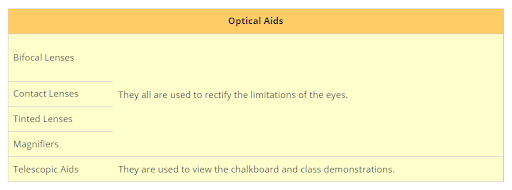
Hum yeh toh jante hai ki hamari eyes spherical shape ki hoti hai lekin kya hamne kabhi different animals ki eyes notice ki hai, woh kaisi hoti hai?
Animals ki eyes different shapes ki hoti hai. Ab hum kuchh animals ki eyes ki shape ke baare mein janege.
What is the Braille System?
Braille system visually challenged people ke liye ek tactual aid hai jiski help se woh read aur write kar sakte hai. Isko ek visually challenged person ne hi develop kiya tha jinko hum Louis Braille ke name se jante hai. Yeh system unhone 1821 mein publish kiya lekin iss system ko 1932 mein adopt kiya gaya. Braille system ki help se hum bahut sari Indian languages ko read kar sakte hai. Common languages, mathematics aur scientific notations ke liye Braille codes present hai. Iss system mein 63 dots ya 63 characters hote hai aur har ek character kisi letter, combination of letters, ek common word ya grammatical sign ko represent karta hai. These are arranged in a cell of two vertical rows having three dots each. Yeh patterns Braille sheet par emboss kiye jate hai aur inko touch karke visually impaired persons words ko recognise kar pate hai aur read kar pate hai. Inn dots ko thoda a raise kiya jata hai taki woh inko easily touch karke recognise kar sake. Niche figure mein hum braille system mein dot patterns ke use ko dekh sakte hai.
Aisa nahi hai ki jo persons visually impaired hai woh life mein kuchh achieve nahi kar sakte. Bahut saare aise visually challenged persons hai jinhone apni lifetime mein bahut sari achievements ki hai.
POINT 1
Light: Light is a form of energy that enables us to see our surroundings when it gets reflected from objects around us.
Reflection of light: When light rays fall on an object their direction changes and they turn back. This is called the reflection of light.
Angle of incidence: The angle which the incident ray makes with the normal is called angle of incidence.
Angle of reflection: The angle which the reflected ray makes with the normal is called angle of reflection.
Lateral inversion: The interchange of left side and right side in image of the object when reflected by a plane mirror is called lateral inversion.
Regular reflection: When light falls on a smooth uniform surface (like a mirror), all the parallel incident rays are reflected perfectly parallel. This is called Regular Reflection.
Diffused reflection: When light falls on a rough surface (like a stone, your body, your clothes etc), all the parallel incident rays are not reflected parallel to each other. This is called Diffused Reflection.
Periscope: A periscope is defined as an instrument used for observing over, around or through an obstacle or object which is prevented by direct line of sight.
Kaleidoscope: A Kaleidoscope is an optical instrument with two or more reflecting surfaces.
Dispersion of light: The splitting up of light into its constituent colours while passing from one medium to the other is called dispersion.
Iris: Iris is the coloured part of the eye.
Cornea: The front part of eye is called cornea.
Pupil: A small opening in the iris is known as a pupil.
Retina: The retina is a screen on which the image is formed in the eye.
Blind spot: Blind spot is a tiny area at the back of each eye, where the optic nerve passes through the optic disk and out of the eyes.
SUMMARY
1. Light is reflected from all surfaces.
2. Regular reflection takes place when light is incident on smooth, polished and regular surfaces.
3. Diffused or irregular reflection takes place from rough surfaces.
4. Two laws of reflection are (i) The angle of incidence is equal to the angle of reflection. (ii) Incident ray, reflected ray and the normal drawn at the point of incidence to the reflecting surface, lie in the same plane.
5. Image formed in a plane mirror undergoes lateral inversion.
6. Two mirrors inclined to each other give multiple images.
7. Beautiful patterns are formed in a kaleidoscope because of multiple reflections.
8. Sunlight, called white light, consists of seven colours.
9. Splitting of light into its constituent colours is known as dispersion.
10. Parts of the eye are cornea, iris, pupil, lens, retina and optic nerve.
11. A normal eye can see nearby and distant objects clearly.
12. Visually impaired persons can read and write using the Braille system.
13. Visually impaired persons develop their other senses more sharply to improve their interaction with their environment.
